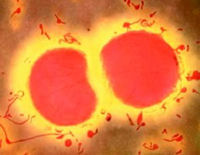An ongoing dialogue on HIV/AIDS, infectious diseases,
February 26th, 2009
Meningococcal Resistance to Ciprofloxacin
 Ciprofloxacin-resistant Neisseria meningitidis has now been documented in the United States. Here’s a nice summary in Journal Watch, with two different perspectives.
Ciprofloxacin-resistant Neisseria meningitidis has now been documented in the United States. Here’s a nice summary in Journal Watch, with two different perspectives.
I suppose we shouldn’t be surprised, but it did take a while. (At least compared to that other famous neisseria-bug, Neisseria gonorrhoeae.)
Oh well.
Why is this important? As every practicing ID doc/primary care provider/public health official knows, nothing strikes fear into a community quite like a case of invasive meningococcal disease. Since household contacts of these cases have a many-fold increased risk of developing the disease, preventive therapy is recommended for any close contact — with “close” being defined nicely by one infection-control practitioner I know as “coughing distance.”
But we all know that prophylaxis extends way beyond this — not surprisingly, many more people request and get preventive therapy than actually need it, and in part this is because it’s so easy to do: a single dose of ciprofloxacin.
Now this needs to be reconsidered. Although it’s up to each local department of health to determine the recommended preventive therapy, I suspect it won’t be long before we’re all back to rifampin (four doses over two days, drug interactions) or a shot of ceftriaxone (ouch).


Unfortunate phrasing, to say that cipro-resistant Neisseria meningitidis has just been documented in the US. It’s been endemic in the US state of Hawaii for many years. For example, see http://hawaii.gov/health/about/healthy-lifestyles/std-aids/info-medical-providers/index.html#6.
Crimony–hoisted by my own unfortunate mind-block: I was reading Neisseria gonorrhoeae (is that the species shown in the artificially-colored image?) while reading and typing Neisseria meningitidis. Forgive my mistaken comment.
Gerald, my images are obtained from that highly-scientific web site aggregating machine, “Google Images”.
This particular one came from a U of Wisconsin educational site that at least said this image was N meningitidis. MultipleOrganisms.net